SOC297: Exploring Bangladeshi Immigrant Life in Lakemba, Australia
VerifiedAdded on 2023/04/06
|8
|1740
|267
Project
AI Summary
This project is an ethnographic study of the Bangladeshi community in Lakemba, New South Wales, Australia, presented as a photo blog. It explores the themes of migration, superdiversity, and the establishment of a distinct cultural identity within an Australian urban landscape. The blog reflects on the experiences of Bangladeshi immigrants, their economic activities, food culture, and religious practices in Lakemba. The author uses images and commentary to connect theoretical concepts from the SOC297 course to the observed realities of the community, highlighting the significance of international labor migration and the integration of immigrants into Australian society. The study also touches upon the challenges and opportunities faced by the Bangladeshi community as they navigate their new environment, emphasizing the importance of understanding migration policies and their impact on both the immigrants and the host country. This assignment is available on Desklib, a platform offering a wide range of study tools and resources for students.
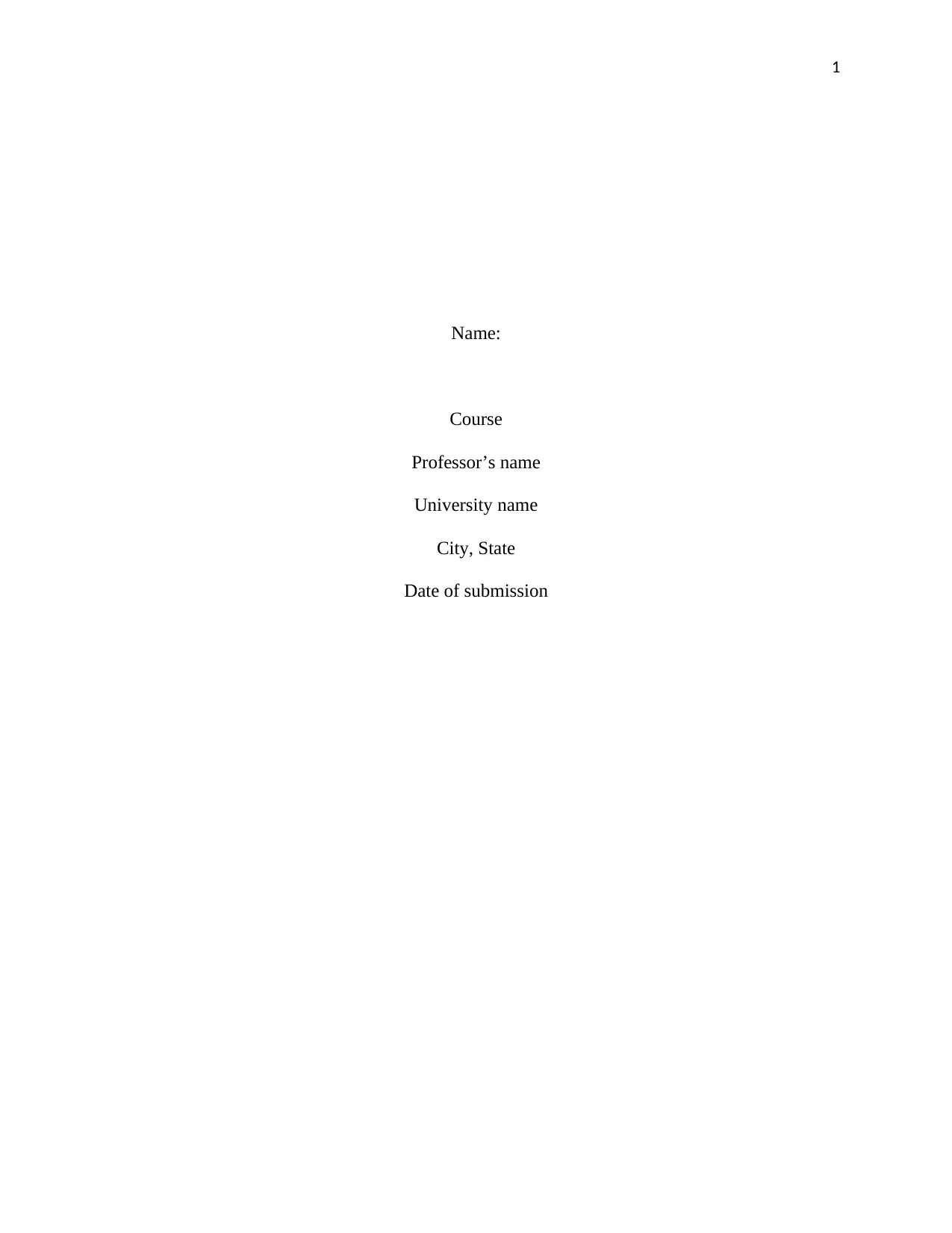
1
Name:
Course
Professor’s name
University name
City, State
Date of submission
Name:
Course
Professor’s name
University name
City, State
Date of submission
Paraphrase This Document
Need a fresh take? Get an instant paraphrase of this document with our AI Paraphraser
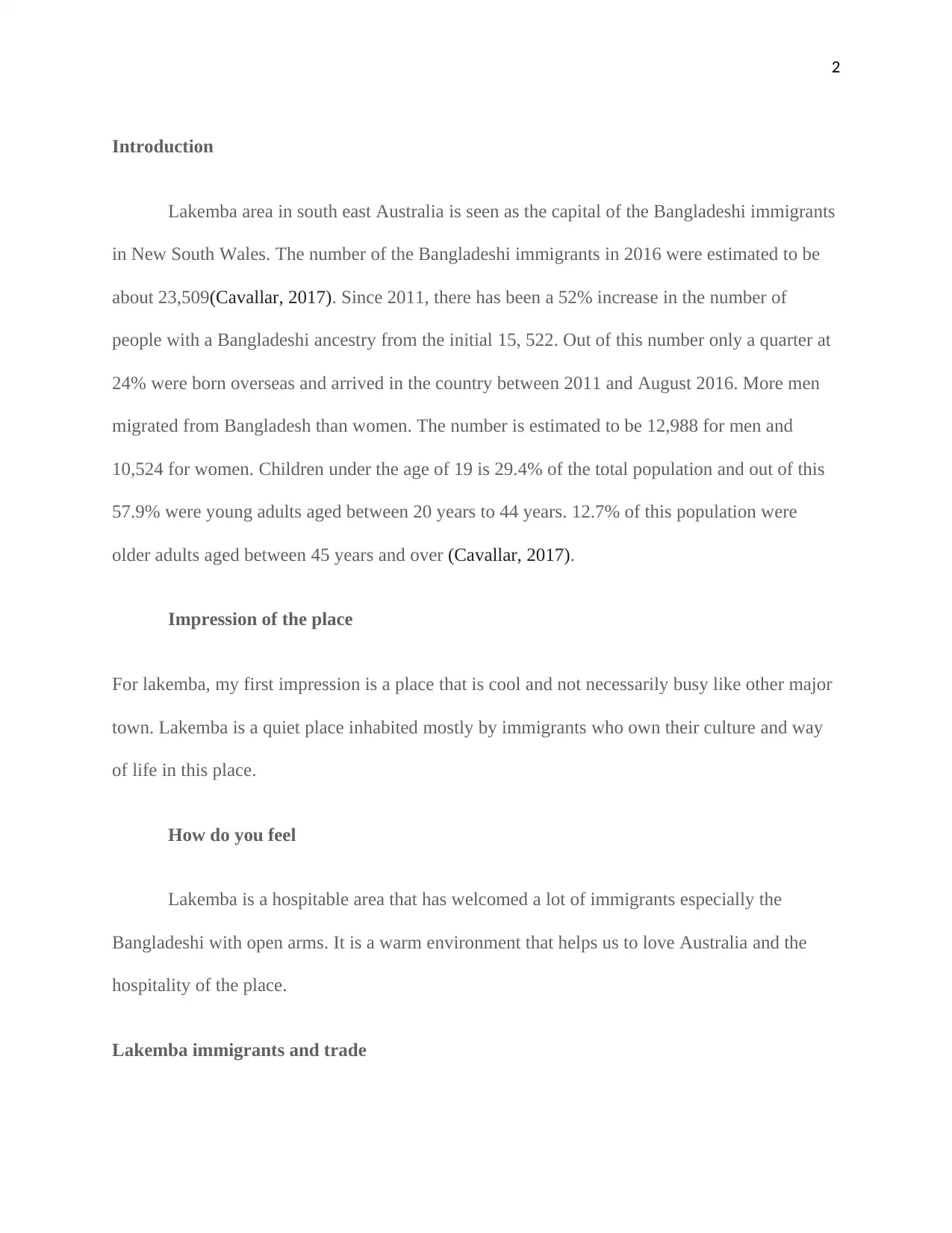
2
Introduction
Lakemba area in south east Australia is seen as the capital of the Bangladeshi immigrants
in New South Wales. The number of the Bangladeshi immigrants in 2016 were estimated to be
about 23,509(Cavallar, 2017). Since 2011, there has been a 52% increase in the number of
people with a Bangladeshi ancestry from the initial 15, 522. Out of this number only a quarter at
24% were born overseas and arrived in the country between 2011 and August 2016. More men
migrated from Bangladesh than women. The number is estimated to be 12,988 for men and
10,524 for women. Children under the age of 19 is 29.4% of the total population and out of this
57.9% were young adults aged between 20 years to 44 years. 12.7% of this population were
older adults aged between 45 years and over (Cavallar, 2017).
Impression of the place
For lakemba, my first impression is a place that is cool and not necessarily busy like other major
town. Lakemba is a quiet place inhabited mostly by immigrants who own their culture and way
of life in this place.
How do you feel
Lakemba is a hospitable area that has welcomed a lot of immigrants especially the
Bangladeshi with open arms. It is a warm environment that helps us to love Australia and the
hospitality of the place.
Lakemba immigrants and trade
Introduction
Lakemba area in south east Australia is seen as the capital of the Bangladeshi immigrants
in New South Wales. The number of the Bangladeshi immigrants in 2016 were estimated to be
about 23,509(Cavallar, 2017). Since 2011, there has been a 52% increase in the number of
people with a Bangladeshi ancestry from the initial 15, 522. Out of this number only a quarter at
24% were born overseas and arrived in the country between 2011 and August 2016. More men
migrated from Bangladesh than women. The number is estimated to be 12,988 for men and
10,524 for women. Children under the age of 19 is 29.4% of the total population and out of this
57.9% were young adults aged between 20 years to 44 years. 12.7% of this population were
older adults aged between 45 years and over (Cavallar, 2017).
Impression of the place
For lakemba, my first impression is a place that is cool and not necessarily busy like other major
town. Lakemba is a quiet place inhabited mostly by immigrants who own their culture and way
of life in this place.
How do you feel
Lakemba is a hospitable area that has welcomed a lot of immigrants especially the
Bangladeshi with open arms. It is a warm environment that helps us to love Australia and the
hospitality of the place.
Lakemba immigrants and trade
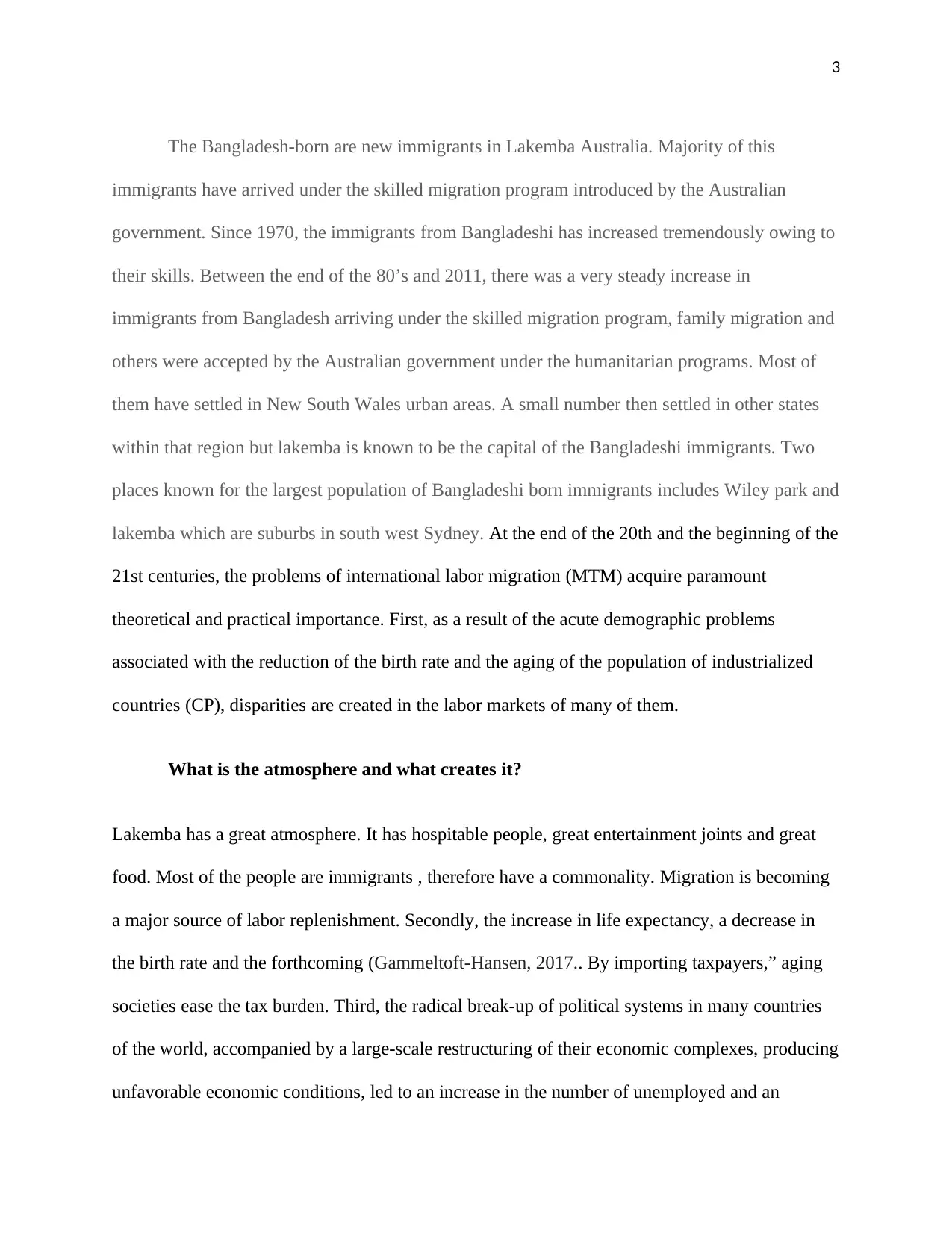
3
The Bangladesh-born are new immigrants in Lakemba Australia. Majority of this
immigrants have arrived under the skilled migration program introduced by the Australian
government. Since 1970, the immigrants from Bangladeshi has increased tremendously owing to
their skills. Between the end of the 80’s and 2011, there was a very steady increase in
immigrants from Bangladesh arriving under the skilled migration program, family migration and
others were accepted by the Australian government under the humanitarian programs. Most of
them have settled in New South Wales urban areas. A small number then settled in other states
within that region but lakemba is known to be the capital of the Bangladeshi immigrants. Two
places known for the largest population of Bangladeshi born immigrants includes Wiley park and
lakemba which are suburbs in south west Sydney. At the end of the 20th and the beginning of the
21st centuries, the problems of international labor migration (MTM) acquire paramount
theoretical and practical importance. First, as a result of the acute demographic problems
associated with the reduction of the birth rate and the aging of the population of industrialized
countries (CP), disparities are created in the labor markets of many of them.
What is the atmosphere and what creates it?
Lakemba has a great atmosphere. It has hospitable people, great entertainment joints and great
food. Most of the people are immigrants , therefore have a commonality. Migration is becoming
a major source of labor replenishment. Secondly, the increase in life expectancy, a decrease in
the birth rate and the forthcoming (Gammeltoft-Hansen, 2017.. By importing taxpayers,” aging
societies ease the tax burden. Third, the radical break-up of political systems in many countries
of the world, accompanied by a large-scale restructuring of their economic complexes, producing
unfavorable economic conditions, led to an increase in the number of unemployed and an
The Bangladesh-born are new immigrants in Lakemba Australia. Majority of this
immigrants have arrived under the skilled migration program introduced by the Australian
government. Since 1970, the immigrants from Bangladeshi has increased tremendously owing to
their skills. Between the end of the 80’s and 2011, there was a very steady increase in
immigrants from Bangladesh arriving under the skilled migration program, family migration and
others were accepted by the Australian government under the humanitarian programs. Most of
them have settled in New South Wales urban areas. A small number then settled in other states
within that region but lakemba is known to be the capital of the Bangladeshi immigrants. Two
places known for the largest population of Bangladeshi born immigrants includes Wiley park and
lakemba which are suburbs in south west Sydney. At the end of the 20th and the beginning of the
21st centuries, the problems of international labor migration (MTM) acquire paramount
theoretical and practical importance. First, as a result of the acute demographic problems
associated with the reduction of the birth rate and the aging of the population of industrialized
countries (CP), disparities are created in the labor markets of many of them.
What is the atmosphere and what creates it?
Lakemba has a great atmosphere. It has hospitable people, great entertainment joints and great
food. Most of the people are immigrants , therefore have a commonality. Migration is becoming
a major source of labor replenishment. Secondly, the increase in life expectancy, a decrease in
the birth rate and the forthcoming (Gammeltoft-Hansen, 2017.. By importing taxpayers,” aging
societies ease the tax burden. Third, the radical break-up of political systems in many countries
of the world, accompanied by a large-scale restructuring of their economic complexes, producing
unfavorable economic conditions, led to an increase in the number of unemployed and an
⊘ This is a preview!⊘
Do you want full access?
Subscribe today to unlock all pages.

Trusted by 1+ million students worldwide
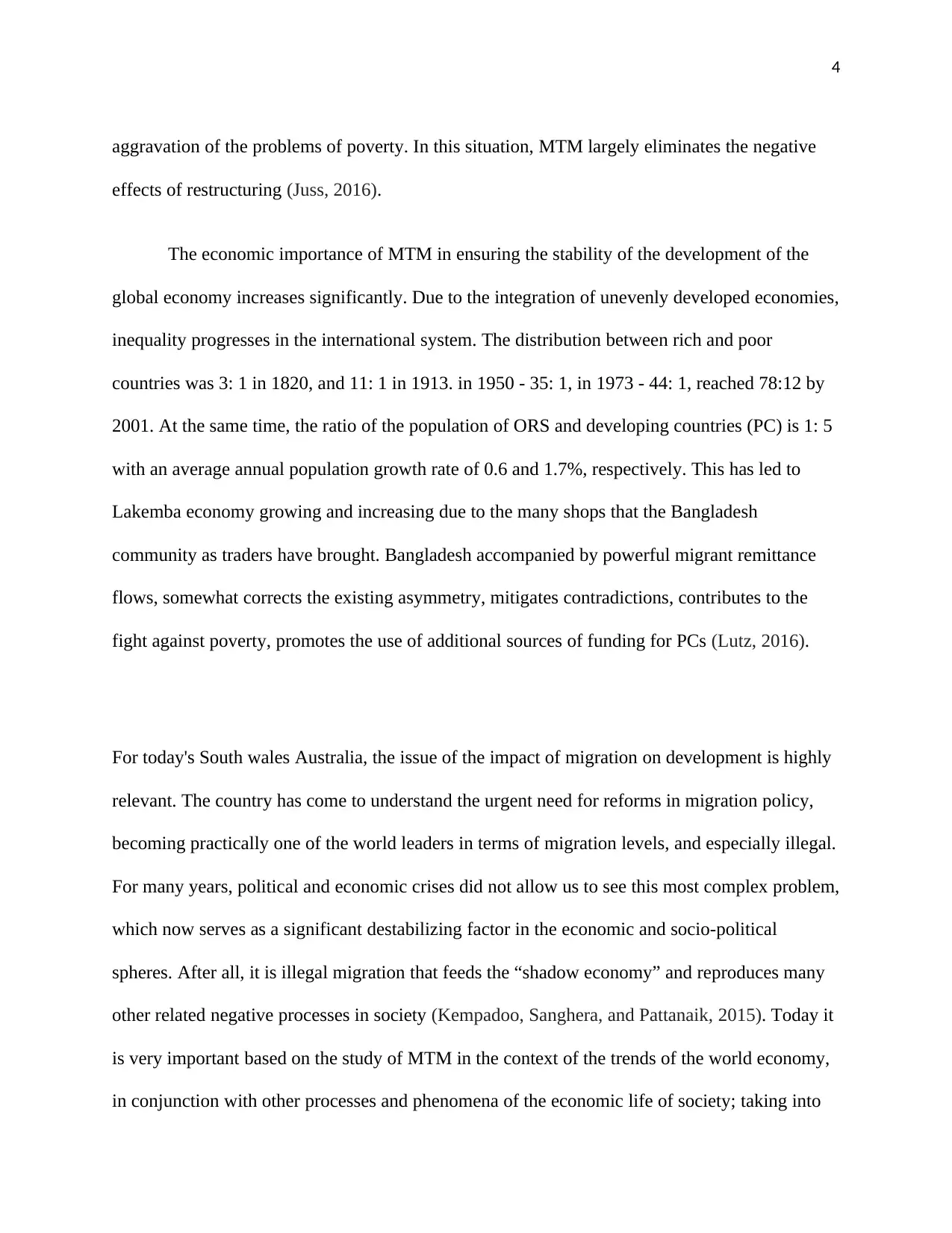
4
aggravation of the problems of poverty. In this situation, MTM largely eliminates the negative
effects of restructuring (Juss, 2016).
The economic importance of MTM in ensuring the stability of the development of the
global economy increases significantly. Due to the integration of unevenly developed economies,
inequality progresses in the international system. The distribution between rich and poor
countries was 3: 1 in 1820, and 11: 1 in 1913. in 1950 - 35: 1, in 1973 - 44: 1, reached 78:12 by
2001. At the same time, the ratio of the population of ORS and developing countries (PC) is 1: 5
with an average annual population growth rate of 0.6 and 1.7%, respectively. This has led to
Lakemba economy growing and increasing due to the many shops that the Bangladesh
community as traders have brought. Bangladesh accompanied by powerful migrant remittance
flows, somewhat corrects the existing asymmetry, mitigates contradictions, contributes to the
fight against poverty, promotes the use of additional sources of funding for PCs (Lutz, 2016).
For today's South wales Australia, the issue of the impact of migration on development is highly
relevant. The country has come to understand the urgent need for reforms in migration policy,
becoming practically one of the world leaders in terms of migration levels, and especially illegal.
For many years, political and economic crises did not allow us to see this most complex problem,
which now serves as a significant destabilizing factor in the economic and socio-political
spheres. After all, it is illegal migration that feeds the “shadow economy” and reproduces many
other related negative processes in society (Kempadoo, Sanghera, and Pattanaik, 2015). Today it
is very important based on the study of MTM in the context of the trends of the world economy,
in conjunction with other processes and phenomena of the economic life of society; taking into
aggravation of the problems of poverty. In this situation, MTM largely eliminates the negative
effects of restructuring (Juss, 2016).
The economic importance of MTM in ensuring the stability of the development of the
global economy increases significantly. Due to the integration of unevenly developed economies,
inequality progresses in the international system. The distribution between rich and poor
countries was 3: 1 in 1820, and 11: 1 in 1913. in 1950 - 35: 1, in 1973 - 44: 1, reached 78:12 by
2001. At the same time, the ratio of the population of ORS and developing countries (PC) is 1: 5
with an average annual population growth rate of 0.6 and 1.7%, respectively. This has led to
Lakemba economy growing and increasing due to the many shops that the Bangladesh
community as traders have brought. Bangladesh accompanied by powerful migrant remittance
flows, somewhat corrects the existing asymmetry, mitigates contradictions, contributes to the
fight against poverty, promotes the use of additional sources of funding for PCs (Lutz, 2016).
For today's South wales Australia, the issue of the impact of migration on development is highly
relevant. The country has come to understand the urgent need for reforms in migration policy,
becoming practically one of the world leaders in terms of migration levels, and especially illegal.
For many years, political and economic crises did not allow us to see this most complex problem,
which now serves as a significant destabilizing factor in the economic and socio-political
spheres. After all, it is illegal migration that feeds the “shadow economy” and reproduces many
other related negative processes in society (Kempadoo, Sanghera, and Pattanaik, 2015). Today it
is very important based on the study of MTM in the context of the trends of the world economy,
in conjunction with other processes and phenomena of the economic life of society; taking into
Paraphrase This Document
Need a fresh take? Get an instant paraphrase of this document with our AI Paraphraser
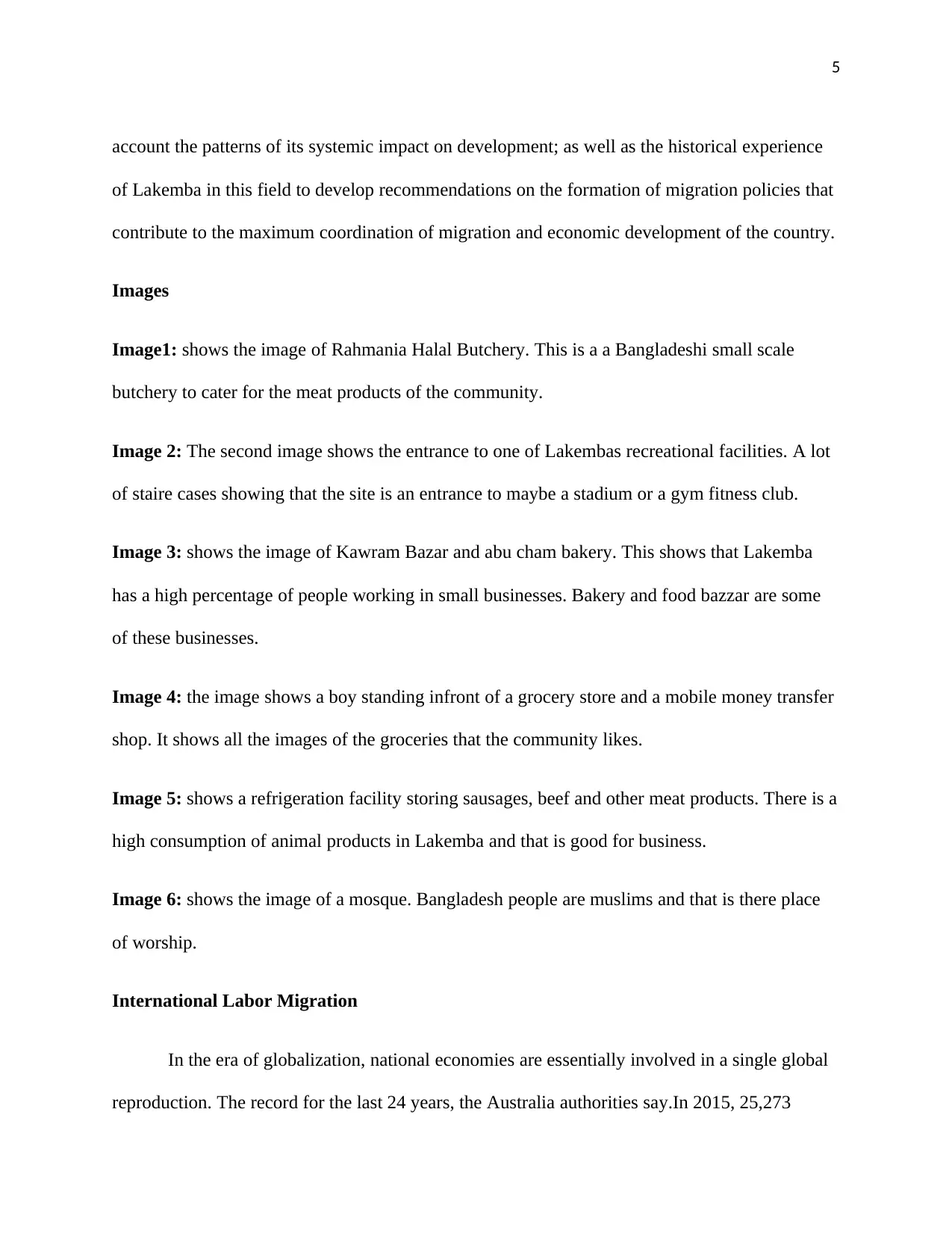
5
account the patterns of its systemic impact on development; as well as the historical experience
of Lakemba in this field to develop recommendations on the formation of migration policies that
contribute to the maximum coordination of migration and economic development of the country.
Images
Image1: shows the image of Rahmania Halal Butchery. This is a a Bangladeshi small scale
butchery to cater for the meat products of the community.
Image 2: The second image shows the entrance to one of Lakembas recreational facilities. A lot
of staire cases showing that the site is an entrance to maybe a stadium or a gym fitness club.
Image 3: shows the image of Kawram Bazar and abu cham bakery. This shows that Lakemba
has a high percentage of people working in small businesses. Bakery and food bazzar are some
of these businesses.
Image 4: the image shows a boy standing infront of a grocery store and a mobile money transfer
shop. It shows all the images of the groceries that the community likes.
Image 5: shows a refrigeration facility storing sausages, beef and other meat products. There is a
high consumption of animal products in Lakemba and that is good for business.
Image 6: shows the image of a mosque. Bangladesh people are muslims and that is there place
of worship.
International Labor Migration
In the era of globalization, national economies are essentially involved in a single global
reproduction. The record for the last 24 years, the Australia authorities say.In 2015, 25,273
account the patterns of its systemic impact on development; as well as the historical experience
of Lakemba in this field to develop recommendations on the formation of migration policies that
contribute to the maximum coordination of migration and economic development of the country.
Images
Image1: shows the image of Rahmania Halal Butchery. This is a a Bangladeshi small scale
butchery to cater for the meat products of the community.
Image 2: The second image shows the entrance to one of Lakembas recreational facilities. A lot
of staire cases showing that the site is an entrance to maybe a stadium or a gym fitness club.
Image 3: shows the image of Kawram Bazar and abu cham bakery. This shows that Lakemba
has a high percentage of people working in small businesses. Bakery and food bazzar are some
of these businesses.
Image 4: the image shows a boy standing infront of a grocery store and a mobile money transfer
shop. It shows all the images of the groceries that the community likes.
Image 5: shows a refrigeration facility storing sausages, beef and other meat products. There is a
high consumption of animal products in Lakemba and that is good for business.
Image 6: shows the image of a mosque. Bangladesh people are muslims and that is there place
of worship.
International Labor Migration
In the era of globalization, national economies are essentially involved in a single global
reproduction. The record for the last 24 years, the Australia authorities say.In 2015, 25,273
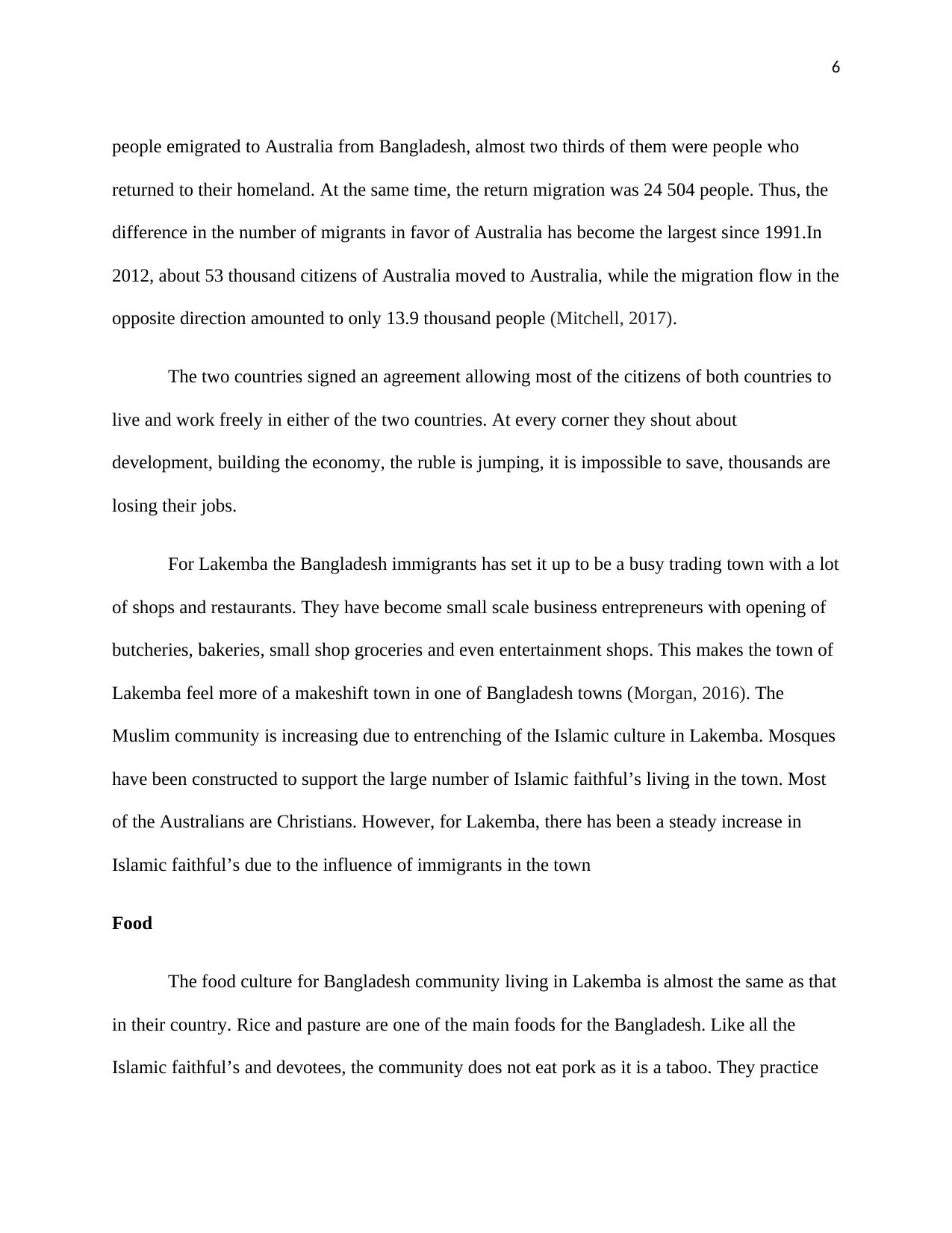
6
people emigrated to Australia from Bangladesh, almost two thirds of them were people who
returned to their homeland. At the same time, the return migration was 24 504 people. Thus, the
difference in the number of migrants in favor of Australia has become the largest since 1991.In
2012, about 53 thousand citizens of Australia moved to Australia, while the migration flow in the
opposite direction amounted to only 13.9 thousand people (Mitchell, 2017).
The two countries signed an agreement allowing most of the citizens of both countries to
live and work freely in either of the two countries. At every corner they shout about
development, building the economy, the ruble is jumping, it is impossible to save, thousands are
losing their jobs.
For Lakemba the Bangladesh immigrants has set it up to be a busy trading town with a lot
of shops and restaurants. They have become small scale business entrepreneurs with opening of
butcheries, bakeries, small shop groceries and even entertainment shops. This makes the town of
Lakemba feel more of a makeshift town in one of Bangladesh towns (Morgan, 2016). The
Muslim community is increasing due to entrenching of the Islamic culture in Lakemba. Mosques
have been constructed to support the large number of Islamic faithful’s living in the town. Most
of the Australians are Christians. However, for Lakemba, there has been a steady increase in
Islamic faithful’s due to the influence of immigrants in the town
Food
The food culture for Bangladesh community living in Lakemba is almost the same as that
in their country. Rice and pasture are one of the main foods for the Bangladesh. Like all the
Islamic faithful’s and devotees, the community does not eat pork as it is a taboo. They practice
people emigrated to Australia from Bangladesh, almost two thirds of them were people who
returned to their homeland. At the same time, the return migration was 24 504 people. Thus, the
difference in the number of migrants in favor of Australia has become the largest since 1991.In
2012, about 53 thousand citizens of Australia moved to Australia, while the migration flow in the
opposite direction amounted to only 13.9 thousand people (Mitchell, 2017).
The two countries signed an agreement allowing most of the citizens of both countries to
live and work freely in either of the two countries. At every corner they shout about
development, building the economy, the ruble is jumping, it is impossible to save, thousands are
losing their jobs.
For Lakemba the Bangladesh immigrants has set it up to be a busy trading town with a lot
of shops and restaurants. They have become small scale business entrepreneurs with opening of
butcheries, bakeries, small shop groceries and even entertainment shops. This makes the town of
Lakemba feel more of a makeshift town in one of Bangladesh towns (Morgan, 2016). The
Muslim community is increasing due to entrenching of the Islamic culture in Lakemba. Mosques
have been constructed to support the large number of Islamic faithful’s living in the town. Most
of the Australians are Christians. However, for Lakemba, there has been a steady increase in
Islamic faithful’s due to the influence of immigrants in the town
Food
The food culture for Bangladesh community living in Lakemba is almost the same as that
in their country. Rice and pasture are one of the main foods for the Bangladesh. Like all the
Islamic faithful’s and devotees, the community does not eat pork as it is a taboo. They practice
⊘ This is a preview!⊘
Do you want full access?
Subscribe today to unlock all pages.

Trusted by 1+ million students worldwide
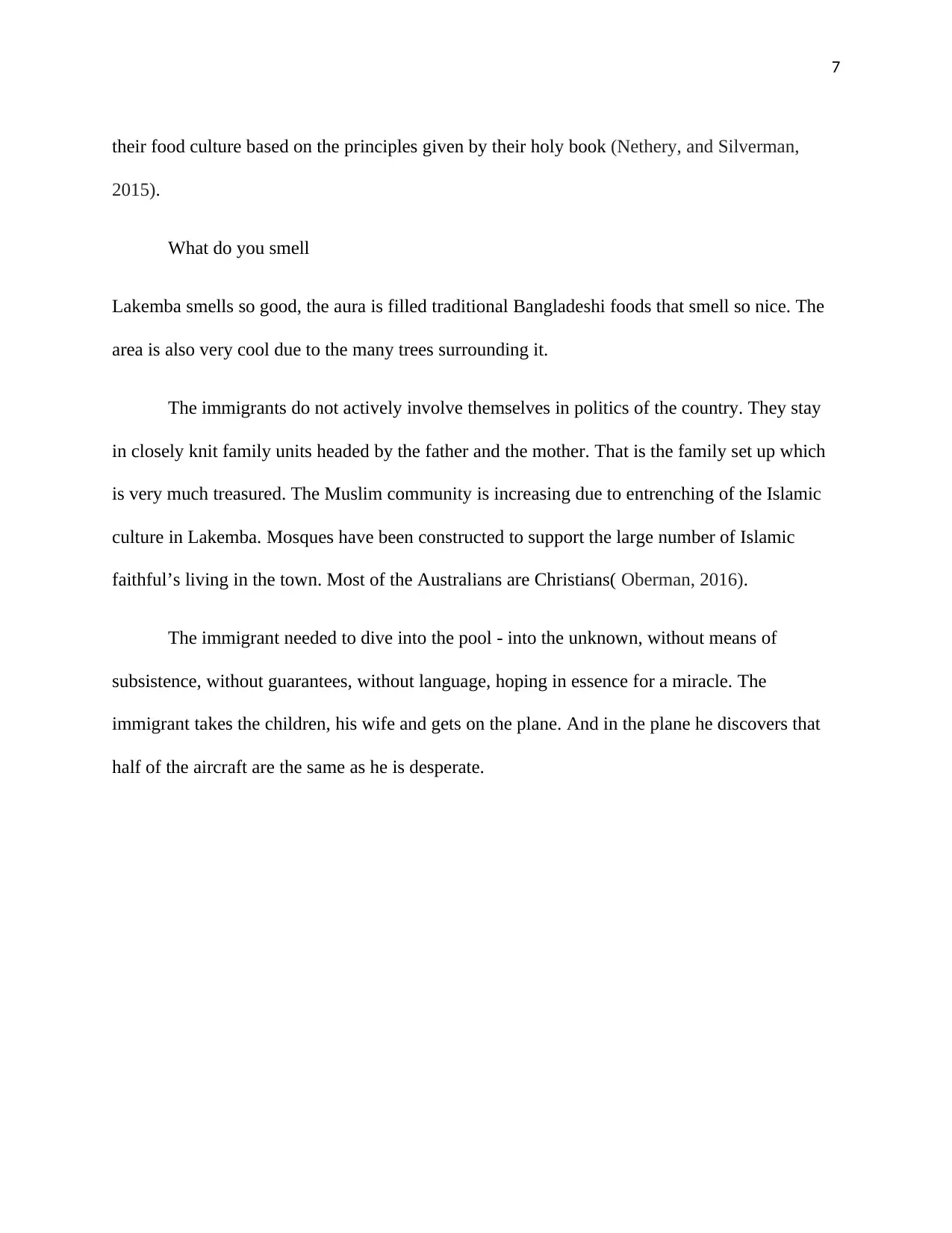
7
their food culture based on the principles given by their holy book (Nethery, and Silverman,
2015).
What do you smell
Lakemba smells so good, the aura is filled traditional Bangladeshi foods that smell so nice. The
area is also very cool due to the many trees surrounding it.
The immigrants do not actively involve themselves in politics of the country. They stay
in closely knit family units headed by the father and the mother. That is the family set up which
is very much treasured. The Muslim community is increasing due to entrenching of the Islamic
culture in Lakemba. Mosques have been constructed to support the large number of Islamic
faithful’s living in the town. Most of the Australians are Christians( Oberman, 2016).
The immigrant needed to dive into the pool - into the unknown, without means of
subsistence, without guarantees, without language, hoping in essence for a miracle. The
immigrant takes the children, his wife and gets on the plane. And in the plane he discovers that
half of the aircraft are the same as he is desperate.
their food culture based on the principles given by their holy book (Nethery, and Silverman,
2015).
What do you smell
Lakemba smells so good, the aura is filled traditional Bangladeshi foods that smell so nice. The
area is also very cool due to the many trees surrounding it.
The immigrants do not actively involve themselves in politics of the country. They stay
in closely knit family units headed by the father and the mother. That is the family set up which
is very much treasured. The Muslim community is increasing due to entrenching of the Islamic
culture in Lakemba. Mosques have been constructed to support the large number of Islamic
faithful’s living in the town. Most of the Australians are Christians( Oberman, 2016).
The immigrant needed to dive into the pool - into the unknown, without means of
subsistence, without guarantees, without language, hoping in essence for a miracle. The
immigrant takes the children, his wife and gets on the plane. And in the plane he discovers that
half of the aircraft are the same as he is desperate.
Paraphrase This Document
Need a fresh take? Get an instant paraphrase of this document with our AI Paraphraser
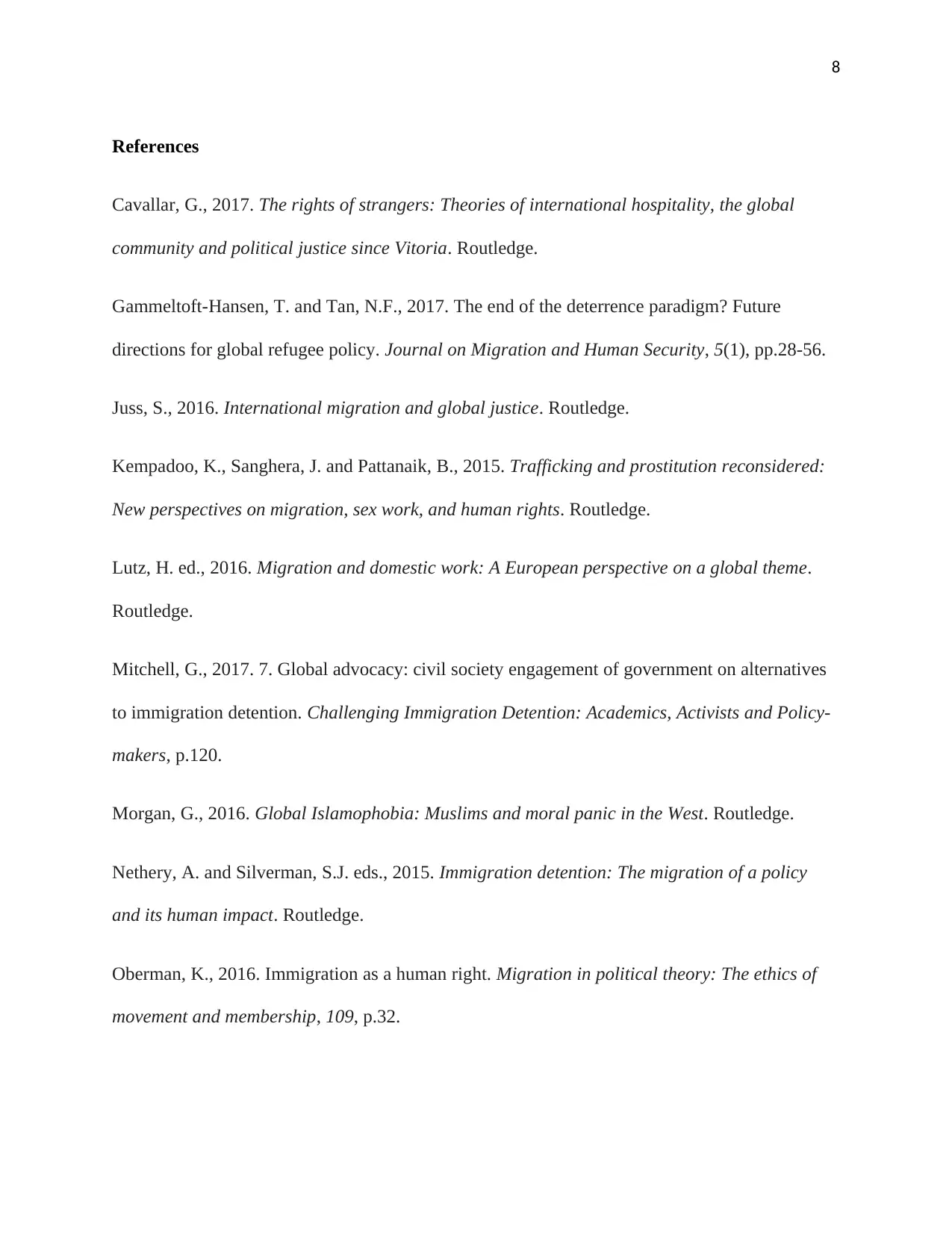
8
References
Cavallar, G., 2017. The rights of strangers: Theories of international hospitality, the global
community and political justice since Vitoria. Routledge.
Gammeltoft-Hansen, T. and Tan, N.F., 2017. The end of the deterrence paradigm? Future
directions for global refugee policy. Journal on Migration and Human Security, 5(1), pp.28-56.
Juss, S., 2016. International migration and global justice. Routledge.
Kempadoo, K., Sanghera, J. and Pattanaik, B., 2015. Trafficking and prostitution reconsidered:
New perspectives on migration, sex work, and human rights. Routledge.
Lutz, H. ed., 2016. Migration and domestic work: A European perspective on a global theme.
Routledge.
Mitchell, G., 2017. 7. Global advocacy: civil society engagement of government on alternatives
to immigration detention. Challenging Immigration Detention: Academics, Activists and Policy-
makers, p.120.
Morgan, G., 2016. Global Islamophobia: Muslims and moral panic in the West. Routledge.
Nethery, A. and Silverman, S.J. eds., 2015. Immigration detention: The migration of a policy
and its human impact. Routledge.
Oberman, K., 2016. Immigration as a human right. Migration in political theory: The ethics of
movement and membership, 109, p.32.
References
Cavallar, G., 2017. The rights of strangers: Theories of international hospitality, the global
community and political justice since Vitoria. Routledge.
Gammeltoft-Hansen, T. and Tan, N.F., 2017. The end of the deterrence paradigm? Future
directions for global refugee policy. Journal on Migration and Human Security, 5(1), pp.28-56.
Juss, S., 2016. International migration and global justice. Routledge.
Kempadoo, K., Sanghera, J. and Pattanaik, B., 2015. Trafficking and prostitution reconsidered:
New perspectives on migration, sex work, and human rights. Routledge.
Lutz, H. ed., 2016. Migration and domestic work: A European perspective on a global theme.
Routledge.
Mitchell, G., 2017. 7. Global advocacy: civil society engagement of government on alternatives
to immigration detention. Challenging Immigration Detention: Academics, Activists and Policy-
makers, p.120.
Morgan, G., 2016. Global Islamophobia: Muslims and moral panic in the West. Routledge.
Nethery, A. and Silverman, S.J. eds., 2015. Immigration detention: The migration of a policy
and its human impact. Routledge.
Oberman, K., 2016. Immigration as a human right. Migration in political theory: The ethics of
movement and membership, 109, p.32.
1 out of 8
Related Documents
Your All-in-One AI-Powered Toolkit for Academic Success.
+13062052269
info@desklib.com
Available 24*7 on WhatsApp / Email
![[object Object]](/_next/static/media/star-bottom.7253800d.svg)
Unlock your academic potential
Copyright © 2020–2025 A2Z Services. All Rights Reserved. Developed and managed by ZUCOL.




